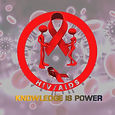The HIV/AIDS Pandemic
South Africa at a Glance
South Africa is situated in Sub-Saharan Africa, being the richest country in the continent. The current GDP is USD $385 billion in 2019. The nation had shown an annual GDP growth rate of 0.6% in the last quarter of 2019. Mining, manufacturing and transport, storage and communication industries contributed the most to the GDP contraction. The 2019, Statistics South Africa (Stats SA) estimates the mid-year population at 59,041,670, approximately 51,2% (approximately 30 million) of the population is female.
South Africa has the biggest and most high-profile HIV epidemic in the world, with the estimated overall HIV prevalence rate at approximately 13,5% among the South African population. The total number of people living with HIV (PLWHIV) is estimated at approximately 7,97 million in 2019. For adults aged 15–49 years, an estimated 20.4% of the population is HIV positive. Over a fifth (3 million) of South African women in their reproductive ages (15–49 years) is HIV positive. Rates in teenage girls are five times than those of boys the same age; and among young adults (early 20s); prevalence rates are three times higher in women. HIV prevalence among the youth aged 15–24 has remained fairly stable over time.
South Africa accounts for a third of all new HIV infections in southern Africa. In 2018, there were 240,000 new HIV infections and 126 805 (23.4%) South Africans died from AIDS-related illnesses.
With the world’s largest antiretroviral treatment (ART) programme (Test and Treat, PrEP and introduction of new Antiretrovirals), South Africa is making good progress towards the UNAIDS 90-90-90 targets, particularly in regards to testing and viral suppression. In 2018, 90% of people living with HIV were aware of their status, of which 68% were on treatment. Of those diagnosed and on treatment, 87% were virally suppressed. This equates to 62% of all people living with HIV in South Africa on treatment and 54% virally suppressed. HIV prevalence remains high, with 20.4% of people (one in five) living with HIV.
The success of South Africa’s ART programme is the evidence in the increase in national life expectancy from 56 years in 2010 to 63 years (2019)
However, the risky cultural practices and illiteracy are probably the most influencing factors behind the alarming HIV/AIDS prevalence rates in South Africa. Widow inheritance, sexual hospitality and “dry sex” are only a few of the common practices which help foster HIV transmission. In most African communities, sex is a taboo subject, and as HIV/AIDS is largely seen as a sexual disease, it is often shrouded in secrecy and disgust. Stigmatisation and ostracization are the usual social consequences of a HIV-positive diagnosis.
Females and youth (especially young girls) are generally disadvantaged, and especially in the African society. Apart from the “receptive” nature of the female genitalia, there are numerous factors behind higher HIV prevalence rates in African women and young girls. They have little or no access to education, employment and healthcare facilities. In addition, in keeping with tradition and cultural norms, they are commonly coerced into marriages and other sexual relationships over which they have little or no control.
.jpg)




